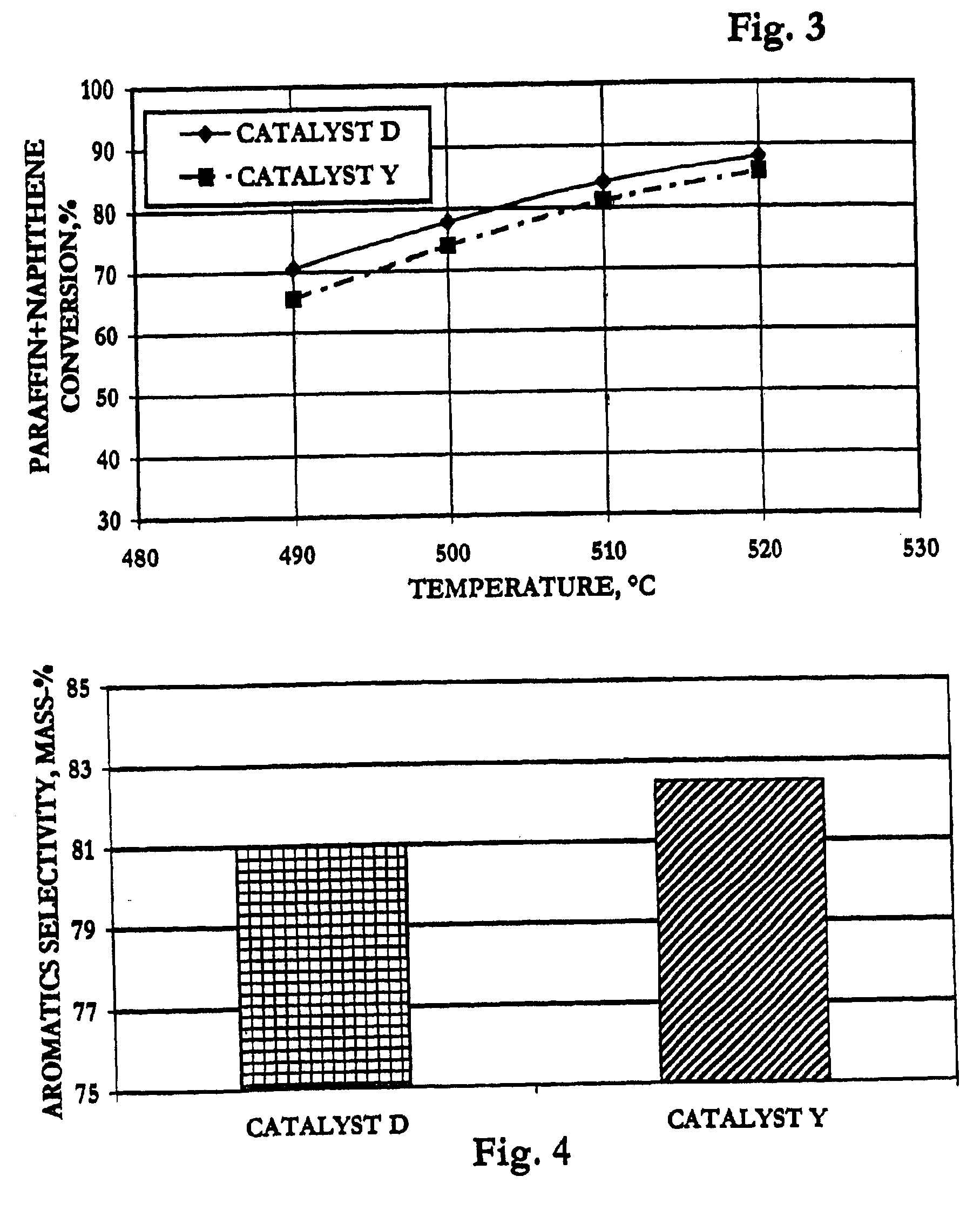Reforming process using a selective bifunctional multimetallic catalyst
a multi-metallic catalyst and selective technology, applied in the direction of metal/metal-oxide/metal-hydroxide catalysts, physical/chemical process catalysts, chemistry apparatuses and processes, etc., can solve the problem of reducing the yield of products boiling in the gasoline range, and achieve the effect of improving selectivity and improving selectivity
- Summary
- Abstract
- Description
- Claims
- Application Information
AI Technical Summary
Benefits of technology
Problems solved by technology
Method used
Image
Examples
examples
[0068]The following examples are presented to elucidate the catalyst and process of the present invention, demonstrating selectivity advantages over prior-art technology. These examples are offered as illustrative embodiments and should not be interpreted as limiting the claims.
[0069]The feedstock used in all but Example VI of the tests of reforming-catalyst performance consisted essentially of 90 mass-% normal heptane (n-heptane) and 10 mass-% orthoxylene. Example VI used an alternative naphtha feedstock described in that section below.
example i
[0070]Two spherical catalysts of the prior art comprising platinum, tin and indium on alumina were prepared by conventional techniques as controls relative to the invention. Tin was incorporated into alumina sol according to the prior art, and the tin-containing alumina sol was oil-dropped to form 1.6 mm spheres which were steamed to dryness at about 10% LOI and calcined at 650° C. The spherical supports then were co-impregnated with indium chloride and chloroplatinic acid in 3% HCl. The impregnated catalysts were dried and oxychlorinated at 525° C. with 2M HCl in air and reduced with pure hydrogen at 565° C.
[0071]The finished controls were designated respectively Catalysts A, B, and D, and each contained about 1.3 mass-% chloride and had the following approximate metals contents as mass-% of the elemental metal:
[0072]
Catalyst:ABDPlatinum0.380.360.29Tin0.30.30.3Indium0.391.140.56
example ii
[0073]A spherical catalyst comprising platinum, tin and cerium on alumina was prepared as a control relative to the invention. Tin was incorporated into a spherical alumina support according to the prior art as described in Example I. The spherical support then was impregnated with cerium nitrate in 3.5% nitric acid at a solution-to-support ratio of 1:1. The resulting composite was steamed to dryness (−10% LOI) and calcined at 650° C. with 3% steam. The resulting calcined composite was impregnated with chloroplatinic acid in HCl to provide 0.38 mass-% Pt in the finished catalyst. The impregnated catalyst was dried and oxychlorinated at 525° C. with 2M HCl in air and reduced with pure H2 at 565° C. The finished Ce-containing catalyst was designated as Catalyst C, contained about 1.4 mass-% chloride and had the following approximate metals contents as mass-% of the elemental metal:
[0074]
PUM
| Property | Measurement | Unit |
|---|---|---|
| pressure | aaaaa | aaaaa |
| temperature | aaaaa | aaaaa |
| mole ratio | aaaaa | aaaaa |
Abstract
Description
Claims
Application Information
 Login to View More
Login to View More - R&D
- Intellectual Property
- Life Sciences
- Materials
- Tech Scout
- Unparalleled Data Quality
- Higher Quality Content
- 60% Fewer Hallucinations
Browse by: Latest US Patents, China's latest patents, Technical Efficacy Thesaurus, Application Domain, Technology Topic, Popular Technical Reports.
© 2025 PatSnap. All rights reserved.Legal|Privacy policy|Modern Slavery Act Transparency Statement|Sitemap|About US| Contact US: help@patsnap.com


